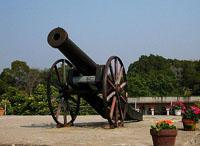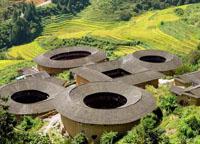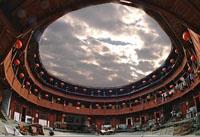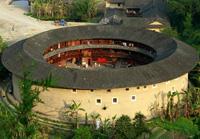Tulou Hakken Earthen Buildings
Exploration Tour

|

Xiamen

Tulou

Tulou

Tulou
|
|
Tulou Hakken Earthen Buildings Exploration Tour
China Cultural
Heritage Tour (3-day)
Highlights:
• Explore the most extraordinary type of Chinese rural
dwelling, the circular Hakka rammed earth buildings, otherwise
known as the Fujian Tulou. It is listed as a UNESCO World
Heritage Site, and you will also get to spend the night in one
of these buildings
• Spend a pleasant day on Gulangyu Island, a serene
pedestrian-only island filled with gardens, villas, and unique
architecture
Standard
Tour and Luxury Tour Packages Available.
B=(Breakfast) L=(lunch) D=(dinner) DEPARTURE: Daily
|
|
|
| |
TOUR ITINERARY |
 |
Tour
code:
P-BX |
|
Day 1: Beijing-Xiamen (by
air) (L)
You will be taken to the Beijing
airport, and from there you will take your flight to
the city of Xiamen, in Fujian province, on the
southeast coast of China. At the airport you will be
met by our English-speaking guide, and we will then
depart by steam-ship (round-trip) to our first
attraction, Gulangyu Island. Gulangyu Island is
renowned for its delicate natural beauty, its
ancient relics, and its varied architecture. The
island is on China's list of National Scenic Spots
and also ranks at the top of the list of the ten
most-scenic areas in Fujian Province. It is a
car-free island, and is a welcome respite to the
frantic activity of the Special Economic Zone just
across the water.
On the island, we will visit Shuzhuang Garden, a
former private villa. It became a garden park open
to the public in 1955. It is divided into two
parts-the Garden of Hiding the Sea (Canghaiyuan) and
the Garden of Making-Up Hills (Bushanyuan). It was
exquisitely designed to embody three important
characteristics in gardening---hiding elements,
borrowing from one's surroundings, and combining
movements. We will also take a look at China’s only
Piano Museum (housing over 200), the Hi Heaven
Museum the largest old villa on the island where you
can enjoy ancient South Music performance and
traditional puppet show. If we’re lucky we can catch
the local style of entertainment, Nanyin Opera.
You can spend the night exploring Xiamen at your own
leisure. Various squares in the city provide popular
nightlife venues for local people to stroll, chat,
and do exercise. At the Egret Alluvion City Park,
there will be musical fountain show at 8:00pm every
day and singing and dancing performances during
weekends. In the Huoshaoyu Islet (or Flaming Islet)
Scenic Area, barbecues will be held at night and
water-screen films will be on show sometimes.
|
Day 2: Xiamen-Nanjing-Yongding
(B, L, D)
In the morning we will drive to
Nanjing, the center for the Hakka earthen buildings.
Hakka, literally, means 'guest' in Chinese. They are
not an ethnic group like the Tibetans or Mongolians.
Their nationality is Han. The ancestors of Hakkas
used to live in central China and were forced to
move southward due to wars, famine and for political
reasons.
The earthen buildings of Hakkas are considered a
wonder of oriental architecture. The buildings
usually are formed as two or three circles. The
outer circle can be as high as 10 meters (31 feet)
and its four stories may hold between one and two
hundred rooms. The kitchen and dining room will be
found on the first or ground floor. The second floor
is used as warehousing, and the third and fourth
floors contain the bedrooms. The inner circle is
2-storied with 30 to 50 rooms which function as a
guesthouse. In the middle is a rectangle hall, a
public place for the several hundred inhabitants.
Our first stop will be at the Tianluokeng Earth
Buildings Complex in Nanjing County. Tianluokeng
Earth Buildings Complex is the Huang Family’s
residence. The Earth Buildings are composed of one
square building (Buyun Building), three circle
buildings (Hechang Building, Zhenchang Building, and
Ruiyun Building) and one oval building (Wenchang
Building). The square building Fangyun Building sets
in the middle while other four buildings surround
it. The buildings scatter and interlock according to
the lie of the mountains. If overlooked from a
higher place, the buildings look like blooming plum
blossoms embellished on the earth embraced by the
mountains. While look up them from the foot of the
mountains, it occupies a mountainside position,
looking down the world like the Potala Palace. As a
combination of exquisite constructions, Tianluokeng
Earth Buildings Complex is a perfect landscape with
the connection of cultural and natural elements and
is acclaimed as the peak of perfection.
At the complex we will wander around and take a peek
at the daily lives of these fascinating peoples. We
will then head to drive to Yongding, where we will
spend the night in an authentic Hakka earthen
building village that is known as a tulou. The tulou
has a shape of an emerging mushroom, or of a falling
flying saucer. In the Cold War, it was even believed
by the Western countries, when examining some tulous,
that is was used as China’s nuclear reactor!
|
Day 3: Yongding-Xiamne-Beijing
(by air) (B, L)
We will spend half the day further
exploring the Hakka earthen tulous. We will first
visit the Zhencheng tulou. Zhencheng, popularly
called Bagua, nad known as “the prince of tulou”, is
a circular tulou built in the year 1912, the first
year of the Republic of China. The building,
consisting of two concentric circles of buildings,
faces the south and covers an area of 5000 square
meters. The outer circle, 4 stories in height with 2
halls and 44 rooms on each floor, is made of rammed
raw earth and divided into 8 units by brick
partition walls. However, as an inner through
corridor layout, all neighboring units are connected
via archway doors in the partition walls. There are
all together 222 rooms (including halls) in the
entire building. The inner space is magnificently
designed, presenting a wonderful example of an
earthen civilian residence that combines the Chinese
style with the Western style of building. In May
2000, Zhencheng Lou was listed among the key
cultural relics protected at national level.
We will then some more Hakka buildings, with Rusheng,
Fuyu, Qujiu, Chenqi, and Jiqing buildings being
among the highlights. The Chenqi tulou in particular
is known as “the king of the tulou”, and has 370
total rooms. At its heyday it housed more than 80
family branches. The buildings are still inhabited
by individual Hakka families and life goes on for
them as usual. This will be an interesting chance to
see daily life, Hakka style.
We will then drive back to Xiamen, and you will be
taken to the airport, where you will fly back to
Beijing.
|
|
Stuff to bring:
• Sturdy shoes or boots, sunglasses and sunscreen
• Bug spray and any other items needed in dealing with the tropical heat
• Tips for a job well done by your guides and drivers, money for any
personal expenses not mentioned
|

